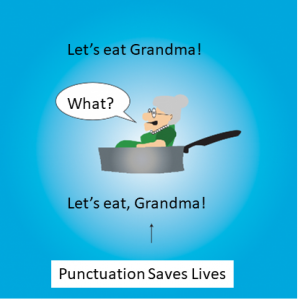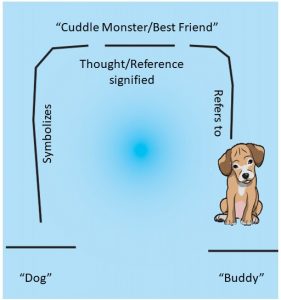How Words Work
Before we jump in to the world of Verbal Communication, please watch the following video as an overview:
The content in this section is from the following open textbook:
Interpersonal Communication: A Mindful Approach to Relationships
Author(s): Jason S. Wrench, Narissra M. Punyanunt-Carter and Katherine S. Thweatt
One person might call a shopping cart a buggy, and another person might call it a cart. There are several ways to say you would like a beverage, such as, “liquid refresher,” “soda,” “Coke,” “pop,” “refreshment,” or “drink.” A pacifier for a baby is sometimes called a “paci,” “binkie,” “sookie,” or “mute button.” Linguist Robin Tolmach Lakoff asks, “How can something that is physically just puffs of air, a mere stand-in for reality, have the power to change us and our world?”1 This example illustrates that meanings are in people, and words don’t necessarily represent what they mean.
Words and Meaning
Words can have different rules to help us understand the meaning. There are three rules: semantic, syntactic, and pragmatic.
Semantic Rules
First, semantic rules are the dictionary definition of the word. However, the meaning can change based on the context in which it is used. For instance, the word fly by itself does not mean anything. It makes more sense if we put the word into a context by saying things like, “There is a fly on the wall;” “I will fly to Dallas tomorrow;” “That girl is so fly;” or “The fly on your pants is open!” We would not be able to communicate with others if we did not have semantic rules.
A cute example of this is about a third-grade teacher who asked about a period. One male student in her class went on and on about how girls have monthly periods, but he did not realize that the teacher meant the use of periods for punctuation at the end of a sentence. Hence, semantic rules need to be understood to avoid embarrassment or misunderstandings.
Syntactic Rules
Second, syntactic rules govern how we help guide the words we use. Syntactic rules can refer to the use of grammar, structure, and punctuation to help effectively convey our ideas. For instance, we can say “Where are you” as opposed to “where you are,” which can convey a different meaning and have different perceptions. The same thing can happen when you don’t place a comma in the right place. The comma can make a big difference in how people under-stand a message.
A great example of how syntactic rules is the Star Wars character, Yoda, who often speaks with different rules. He has said, “Named must be your fear before banish it you can” and “Happens to every guy sometimes this does.” This example illustrates that syntactic rules can vary based on culture or background.
Another example is Figure 4.1. In this case, we learn the importance that a comma can make in written in language. In the first instance, “Let’s eat grandma!” is quite different than the second one, “Let’s eat, grandma!” The first implies cannibalism and the second a family dinner. As the image says, punctuation saves lives.

Pragmatic Rules
Third, pragmatic rules help us interpret messages by analyzing the interaction completely. We need to consider the words used, how they are stated, our relationship with the speaker, and the objectives of our communication. For instance, the words “I want to see you now” would mean different things if the speaker was your boss versus your lover. One could be a positive connotation, and another might be a negative one. The same holds true for humor. If we know that the other person understands and appreciates sarcasm, we might be more likely to engage in that behavior and perceive it differently from someone who takes every word literally.
Most pragmatic rules are based on culture and experience. For instance, the term “Netflix and chill” often means that two people will hook up. Imagine someone from a different country who did not know what this meant; they would be shocked if they thought they were going to watch Netflix with the other person and just relax. Another example would be “Want to have a drink?”, which usually infers an alcoholic beverage. Another way of saying this might be to say, “Would you like something to drink?” The second sentence does not imply that the drink has to contain alcohol.
It is common for people to text in capital letters when they are angry or excited. You would interpret the text differently if the text was not in capital letters. For instance, “I love you” might be perceived differently from “I LOVE YOU!!!” Thus, when communicating with others, you should also realize that pragmatic rules can impact the message.
Words Create Reality
Language helps to create reality. Often, humans will label their experiences. For instance, the word “success” has different interpretations depending on your perceptions. Success to you might be a certain type of car or a certain amount of income. However, for someone else, success might be the freedom to do what they love or to travel to exotic places. Success might mean something different based on your background or your culture.
Another example might be the word “intimacy.” Intimacy to one person might be something similar to love, but to another person, it might be the psychological connection that you feel to another person. Words can impact a person’s reality of what they believe and feel.
If a child complains that they don’t feel loved, but the parents/guardians argue that they continuously show affection by giving hugs and doing fun shared activities, who would you believe? The child might say that they never heard their parents/guardians say the word love, and hence, they don’t feel love. So, when we argue that words can create a person’s reality, that is what we mean. Specific words can make a difference in how a person will receive the message. That is why certain rhetoricians and politicians will spend hours looking for the right word to capture the true essence of a message. A personal trainer might be careful to use the word “overweight” as opposed to “fat,” because it just sounds drastically different. At Disney world, they call their employees “cast members” rather than workers, because it gives a perception that each person has a part in helping to run the show. Even on a resume, you might select words that set you apart from the other applicants. For instance, if you were a cook, you might say “culinary artist.” It gives the impression that you weren’t just cooking food, you were making masterpieces with food. Words matter, and how they are used will make a difference.
Sapir-Whorf Hypothesis
Edward Sapir and Benjamin Lee Whorf developed the Sapir-Whorf hypothesis to explain that language determines thought. People who speak different languages, or use language differently, think differently (Whorf; Sapir; Mandelbaum; Maxwell; Perlovsky; Lucy; Simpson; Hussein). The argument suggests that if a native English speaker had the exact same experiences in their life, but grew up speaking Chinese instead of English, their worldview would be different because of the different symbols used to make sense of the world. When you label, describe, or evaluate events in your life, you use the symbols of the language you speak. Your use of these symbols to represent your reality influences your perspective and attitude about the world. So, it makes sense then that the more sophisticated your repertoire of symbols is, the more sophisticated your world view can be for you. While the Sapir-Whorf hypothesis is highly respected, there have been many scholarly and philosophical challenges to the viewpoint that language is what shapes our worldview. For example, Agustin Vicente and Fernando Martinez-Manrique did a study regarding the “argument of explicitness,” which has two premises. The first premise is that “the instrument of thought must be explicit” in order for thought and language to be connected; the second is that natural languages – languages that humans can learn cognitively as they develop – are not explicit (Vicente and Martinez-Manrique, 384). The authors conclude that thoughts “demand a kind of completeness and stability of meaning that natural language sentences, being remarkably underdetermined, cannot provide” (Vicente and Martinez-Manrique, 397). It makes sense that something as arbitrary and complicated as the connection between thought and language is still being debated today. This is also known as “Linguistic Relativism.”
Words Reflect Attitudes
When we first fall in love with someone, we will use positive adjectives to describe that person. However, if you have fallen out of love with that person, you might use negative or neutral words to describe that same person. Words can reflect attitudes. Some people can label one experience as pleasant and another person can have the opposite experience. This difference is because words reflect our attitudes about things. If a person has positive emotions towards another, they might say that that person is funny, mature, and thrifty. However, if the person has negative feelings or attitudes towards that same person, they might describe them has childish, old, and cheap. These words can give a connotation about how the person perceives them.
Level of Abstraction
When we think of language, it can be pretty abstract. For example, when we say something is “interesting,” it can be positive or negative. That is what we mean when we say that language is abstract. Language can be very specific. You can tell someone specific things to help them better understand what you are trying to say by using specific and concrete examples. For instance, if you say, “You are a jerk!”, the person who receives that message might get pretty angry and wonder why you said that statement. To be clear, it might be better to say something like, “When you slammed that door in my face this morning, it really upset me, and I didn’t think that behavior was appropriate.” The second statement is more descriptive.
In 1941, linguist S.I. Hayakawa created what is called the abstraction ladder (Figure 4.2).3 The abstraction ladder starts abstract at the top, while the bottom rung and is very concrete. In Figure 4.2, we’ve shown how you can go from abstract ideas (e.g., information) through various levels of more concrete ideas to the most concrete idea. Ideally, you can see that as we move down the ladder, the topic becomes more fine-tuned and concrete.
In our daily lives, we tend to use high levels of abstraction all the time. For instance, growing up, your parents/guardians probably helped you with homework, cleaning, cooking, and transporting you from one event to another. Yet, we don’t typically say thank you to everything; we might make a general comment, such as a thank you rather than saying, “Thank you so much for helping me with my math homework and helping me figure out how to solve for the volume of spheres.” It takes too long to say that, so people tend to be abstract. However, abstraction can cause problems if you don’t provide enough description.
 |
Abstract
Concrete |
Information Research Academic Fields Humanities and Social Science Communication Studies Interpersonal Communication
|
Metamessages
Metacommunication is known as communication about communication.4 Yet, metamessages are relationship messages that are sent among people who they communicate. These messages can be verbal, nonverbal, direct, or indirect. For instance, if you see two friends just talking about what they did last weekend, they are also sending metamessages as they talk. Metamessages can convey affection, appreciation, disgust, ridicule, scorn, or contempt. Every time you send messages to others, notice the metamessages that they might be sending you. Do they seem upset or annoyed with certain things that you say? In this book, we want to stress the importance of mindfulness when speaking. You may not realize what metamessages you are sending out to others.
Words and Meanings
Words can have denotative meanings or connotative meanings. In this section, we will learn about the differences and the triangle of meaning. Researchers by the names of Ogden and Richards noticed that misunderstandings occur when people associate different meanings with the same messages. Their model illustrates that there is an indirect association between a word and the actual referent or thing it represents.

As you can see, when you hear the word “dog,” it conjures up meaning for different people. The word “dog” itself is a symbol and signifier, or sound elements or other linguistic symbols that represents an underlying concept or meaning. When we hear the word “dog,” it is what we call the “signified” or the meaning or the idea expressed when someone hears the word. In this case, maybe you have a dog, and you really see that dog as your best friend, or as in this case, you call him the little “cuddle monster” because he always wants to be connected to you at all times. Again, our meaning that we attach to the symbol is still separate from the physical entity itself. In this case, there is a real dog named Teddy, who is the referent, or the physical thing that a word or phrase denotes or stands for.
Words can have a denotative meaning, which is the dictionary definition. These are words that most people are familiar with, and they all can agree on the understanding of that word. If you asked a person what a car or a phone is, they would most likely know what you are talking about when you use those words.
Words can have a connotative meaning, which is a subjective definition of the word. The word might mean something different from what you meant. For example, you may hear someone referring to their baby. You could fairly safely assume that the person is referring to their infant, but just as easily they could be referring to a significant other.

 License:
License: 